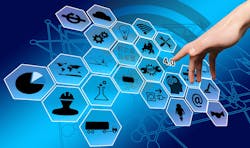7 IoT Predictions for 2018
The buildup is over—we are now officially in the age of IoT adoption. BSquare, a research firm, recently conducted the “Industrial Internet of Things Maturity Study” to determine how companies are adopting IIoT systems. Over 300 companies from the three major industry sectors of manufacturing, transportation, and oil & gas took part in the study.
Specifically, 86% of respondents are currently adopting IIoT applications. Most are in construction and transportation (93%), closely followed by oil & gas (89%), and lastly manufacturing (77%). Roughly 84% of them believe the projects are effective, and 95% state that the IIoT projects are having a significant impact on their business. The majority of the projects (78%) focus on connecting devices and machines, either via Ethernet or cloud services, and 83% of the projects involve data visualization.
Companies that have adopted IoT technology as an essential part of their business model are leading the way when it comes to digital transformation initiatives. According to Vodafone’s IoT Barometer 2017/18, 74% of companies agree that digital transformation is impossible without IoT adoption. The businesses that implemented IoT systems in 2017 or earlier have gotten a head start and maintain a clear advantage over their competitors when it comes to developing digital capabilities in 2018.
As many industries head toward IoT adoption and implementation, here are seven predictions to watch for in the IoT world in 2018:
1. The industrial space has passed the IoT hype hurdle and is into mainstream adoption. Companies are now looking for return of investment in all IoT applications.
Companies have accepted IoT as a main driver of digital transformation. They are now ready to reap the benefits of their investments and will be looking for business value and outcomes in every project. Companies will purchase many new devices with the expectation that they will be installed with sensors and connectivity options. They should understand that while devices may be ready to go, investment into IoT networks is still needed.
2. The IoT cloud platform market will surge and the major players will come forward.
Microsoft Azure and Amazon AWS are poised to be the largest shareholders in the cloud space. IBM Cloud, Google Cloud Platform, SAP Cloud Platform, and Oracle Cloud will round out the market. Many IoT companies like Siemens or General Electric will offer clouds-as-a-service through these companies.
3. IoT systems architecture will evolve from data collection and analytics to an intelligent situation-driven solution for end users.
The data collected from IoT solutions will start to drive new analysis for end users. With the advances in artificial intelligence and computer processing, fields such as data science, machine learning, and physics-based models will extract meaningful events from IoT data to take prescriptive action.
4. The ability of edge devices and fog computing will bring about distributed intelligence.
One aspect of IoT is distributed intelligence. Advances in edge devices and fog computing will create networks that provide analytics at every stage of the process. Edge devices and fog-computing solutions are becoming more intelligent and autonomous, which adds analytics and machine learning, leading to the emergence of distributed edge-cloud programming paradigms.
5. The use of “digital twins” will help companies evolve concepts from digital blueprints to real-world implementation.
The long-term business of IoT is in the network of business partners and digital twins. The ability to create digital twins of products and manufacturing processes offers companies new methods of analysis. The collection of IoT data allows computer models to provide predictive analytics and maintenance.
6. Despite advances in open standards, integration will remain challenging.
Standards are necessary to create a common set of communication tools between companies. Consumers benefit from open standards, as they can mix and match their IoT products. While industry standards like OPC-UA and RAMI will emerge to address semantic integration, it will take a long time for these standards to become fully adopted.
7. Security and privacy will remain key concerns.
IoT security that’s embedded into hardware and network systems has replaced standalone security features. Data privacy legislation and concerns (specifically in Europe and China) will impact IoT architecture. Businesses with large IoT implementations are becoming more confident in new security features. These companies have made significant investments to acquire the expertise and resources necessary to handle security threats. Advances in security will allow companies to share data over internet networks and push businesses forward.
The IoT is rapidly becoming part an essential part of company’s infrastructure. It is now a critical asset. Businesses entering the IoT field in 2018 should consider these trends when building and deploying IoT capabilities.


